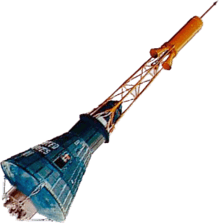Mercury Seven
.jpg)
The Mercury Seven were the group of seven Mercury astronauts announced by NASA on April 9, 1959.[2] They are also referred to as the Original Seven or Astronaut Group 1. They piloted the manned spaceflights of the Mercury program from May 1961 to May 1963. These seven original American astronauts were Scott Carpenter, Gordon Cooper, John Glenn, Gus Grissom, Wally Schirra, Alan Shepard, and Deke Slayton.
Members of the group flew on all classes of NASA manned orbital spacecraft of the 20th century — Mercury, Gemini, Apollo, and the Space Shuttle. Gus Grissom died in 1967, in the Apollo 1 fire. The others all survived past retirement from service. John Glenn went on to become a U.S. senator and flew on the Shuttle 36 years later to become the oldest person to fly in space. He was the last living member of the class when he died in 2016 at the age of 95.[3]
Selection process
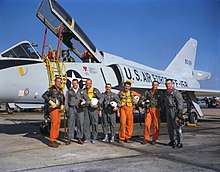
Although NASA planned an open competition for its first astronauts, President Dwight D. Eisenhower insisted that all candidates be test pilots. Because of the small space inside the Mercury spacecraft, candidates could be no taller than 5 feet 11 inches (180 cm) and weigh no more than 180 pounds (82 kg).[4] Other requirements included an age under 40, a bachelor's degree or the professional equivalent, 1,500 hours of flying time, and qualification to fly jet aircraft.[5]:14
After an advertisement among military test pilots drew more than 500 applications, NASA searched military personnel records in January 1959 and identified 110 pilots—five Marines, 47 from the Navy, and 58 from the Air Force[6]—who qualified. Sixty-nine[7] candidates were brought to Washington, DC, in two groups; the candidates' interest was so great, despite the extensive physical and mental exams from January to March, that the agency did not summon the last group.[5]:14–15 The tests included spending hours on treadmills and tilt tables, submerging their feet in ice water, three doses of castor oil, and five enemas.[7] Six candidates were rejected as too tall for the planned spacecraft. Another 33 failed or dropped out during the first phase of exams. Four more refused to take part in the second round of tests, which eliminated eight more candidates, leaving 18.[5]:16[8]
From the 18, the first seven NASA astronauts were chosen,[9] each a "superb physical specimen" with an IQ above 130, and the ability to function well both as part of a team and solo.[7] Grissom, Cooper, and Slayton were Air Force pilots; Shepard, Carpenter, and Schirra were Navy pilots, and Glenn was a Marine Corps pilot.
All seven had attended a variety of postsecondary institutions in the 1940s. Of the five astronauts who had completed undergraduate degrees before being selected, two (Shepard and Schirra) were graduates of the United States Naval Academy. Having earned a Master of Arts degree in 1957 at the Naval War College, Shepard was the only selectee who held an advanced degree. Following a decade of intermittent studies, Cooper completed his degree as a mid-career student at the Air Force Institute of Technology undergraduate program in 1956. Grissom also earned a second bachelor's degree in aeromechanics from the latter institution as a mid-career student. Glenn and Carpenter, however, did not technically meet all of their schools' degree requirements (including the completion of Glenn's senior year in residence and final proficiency exam and Carpenter's final course in heat transfer) due to wartime military service. Although both were admitted on the basis of professional equivalency, Glenn had also completed a wide array of additional coursework as a U.S. Navy aviation cadet from 1942 to 1943 and as a part-time student at the University of Maryland, College Park from 1956 to 1959. Both astronauts were ultimately awarded their bachelor's degrees after their 1962 space flights.[10][11]
NASA introduction
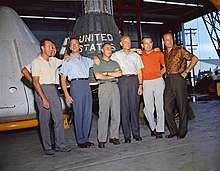
NASA introduced the astronauts in Washington on April 9, 1959. Although the agency viewed Project Mercury's purpose as an experiment to determine whether humans could survive space travel, the seven men immediately became national heroes and were compared by Time magazine to "Columbus, Magellan, Daniel Boone, and the Wright brothers."[7] Two hundred[7] reporters overflowed the room used for the announcement and alarmed the astronauts, who were unused to such a large audience.[5]:16–18
Because they wore civilian clothes, the audience did not see them as military test pilots but "mature, middle-class Americans, average in height and visage, family men all," ready for single combat versus worldwide Communism. To the astronauts' surprise, the reporters asked about their personal lives instead of war records or flight experience, or about the details of Mercury. After Glenn responded by speaking eloquently "on God, country, and family" the others followed his example,[5]:18–19 and the reporters "lustily applauded them."[7]
Group members

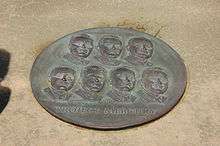
- Malcolm Scott Carpenter (1925–2013), U.S. Navy (1 flight)
- MA-7 (Aurora 7) — May 1962 — Second orbital Mercury mission[12]:352–358
- Leroy Gordon (Gordo) Cooper Jr. (1927–2004), U.S. Air Force (2 flights)
- MA-9 (Faith 7) — May 1963 — Final Mercury mission, first American mission to last more than a day; Cooper became the last American who flew in space alone[12]:494–503
- Gemini 5 — August 1965 — Command Pilot — First eight-day space mission, first use of fuel cells
- John Herschel Glenn Jr. (1921–2016), U.S. Marine Corps (2 flights)
- MA-6 (Friendship 7) — February 1962 — First orbital Mercury flight; Glenn became the first American to orbit the Earth
- STS-95 Discovery — October 1998 — Payload Specialist — Spacelab mission, Spartan 201 release; Glenn became the oldest person in space
- Virgil Ivan (Gus) Grissom (1926–1967), U.S. Air Force (2 flights)
- MR-4 (Liberty Bell 7) — July 1961 — Final suborbital Mercury flight;[12]:365–370 Liberty Bell 7 sank after splashdown and was not retrieved until 1999[13]
- Gemini 3 — March 1965 — Command Pilot — First manned Gemini mission; first manned mission to change orbital plane; Grissom became the first person to be launched into space twice
- Apollo 1 — January 1967 — Commander — Killed in a fire during a launch pad test one month before the launch
- Walter Marty (Wally) Schirra Jr. (1923–2007), U.S. Navy (3 flights)
- MA-8 (Sigma 7) — October 1962 — Third orbital Mercury flight[14]
- Gemini 6A — December 1965 — Command Pilot — First rendezvous in space, with Gemini 7
- Apollo 7 — October 1968 — Commander — First manned Apollo mission; Schirra became the first person to be launched into space three times and the only person to fly Mercury, Gemini, and Apollo missions
- Alan Bartlett Shepard Jr. (1923–1998), U.S. Navy (2 flights)
- MR-3 (Freedom 7) — May 1961 — First manned Mercury flight; Shepard became the first American in space[12]:352–358
- Apollo 14 — January 1971 — Commander — Third manned lunar landing; fifth man to walk on the Moon
- Donald Kent (Deke) Slayton (1924–1993), U.S. Air Force (1 flight)
- Apollo-Soyuz Test Project — July 1975 — Docking Module Pilot — First joint American–Soviet space mission; first docking of an American and Russian spacecraft
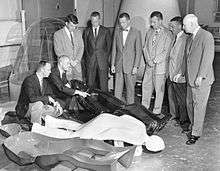
The astronauts participated in Project Mercury's design and planning.[5]:25–26 While busy with such duties and the intense training for their flights,[5]:22 the men also "roughhoused and drank and drove fast and got into sexual peccadilloes." [5]:35 NASA actively sought to protect the astronauts and the agency from negative publicity and maintain an image of "clean-cut, all-American boy[s]."[5]:20
Before Slayton could make his Mercury flight, he was diagnosed in 1962 with an erratic heart rhythm (idiopathic atrial fibrillation), and grounded from flight by NASA and the Air Force. He stayed with the manned space program, first as unofficial "Chief Astronaut", then in November 1963 becoming Coordinator of Astronaut Activities as chief of the Astronaut Office. Later he became Director of Flight Crew Operations responsible for the astronaut contingent of NASA. He left his role upon the start of his training for the Apollo Soyuz Test Project where he flew his first space flight as docking module pilot and at that time became the oldest person in space.
Media attention
The seven astronauts agreed to share equally any proceeds from interviews regardless of who flew first.[7][15] In August 1959, they and their wives signed a contract with Life magazine for $500,000[15] in exchange for exclusive access to their private lives, homes, and families.[5]:16 Their official spokesman from 1959 to 1963 was NASA's public affairs officer, USAF Lt. Col. John "Shorty" Powers, who as a result became known in the press as the "eighth astronaut".
They wrote first-hand accounts of their selection and preparation for the Mercury missions in the 1962 book We Seven. Additionally, each of them separately wrote at least one book describing their astronaut experiences. In 1979, Tom Wolfe published a less sanitized version of their story in The Right Stuff. Wolfe's book was the basis for the film of the same name directed by Philip Kaufman.
The five Tracy brothers from the TV series Thunderbirds were named after five of the Mercury Seven astronauts.
Status after Mercury
- Despite not making a Mercury flight, Slayton stayed with the manned space program, as Director of Flight Crew Operations through the Gemini and Apollo programs, responsible for crew selection and training.[16] In an effort to conquer his fibrillation, he gave up cigarettes and coffee, and placed himself on an intensive exercise and nutrition program. In July 1970, it ceased and he was returned to flight status, and flew on the last Apollo spacecraft in July 1975 as docking module pilot on the Apollo-Soyuz Test Project flight. He left NASA in February 1982.[17]
- Carpenter's performance on his Mercury flight put him at odds with Flight Director Christopher Kraft, resulting in him being blackballed from future flight assignments.[18] He took a leave of absence from NASA in the fall of 1963 to participate in the Navy's SEALAB program. He later sustained a medically grounding injury to his left arm in a motorbike accident. Two surgical interventions in 1964 and 1967 failed to correct the condition, and he resigned from NASA in August 1967.[11]
- Cooper also stayed with Gemini and Apollo, commanding the eight-day Gemini 5 flight in August 1965.[19] But his lax attitude toward training and his personal safety put him at odds with Slayton, who kept him on lower priority on the Gemini and Apollo flight rotations.[20][21] After Shepard was given his potential slot for an Apollo command, he retired from NASA in July 1970.[19]
- According to former NASA administrator Charles Bolden, Glenn became "so valuable to the nation as an iconic figure" that U.S. President John F. Kennedy would not "risk putting him back in space again."[22] He decided to enter politics and left the program in 1964. While a U.S. Senator in 1998, he was chosen to fly as a civilian Payload Specialist on the October–November mission STS-95 of the Space Shuttle Discovery, and, at the age of 77, became the oldest person to fly in space as of April 2017.[23] He died on December 8, 2016, aged 95;[24][25] he was the last living member of the Mercury Seven.
- Grissom played a role in the design of the Gemini spacecraft, and replaced Shepard as commander of the first flight, Gemini 3 in March 1965. He was also active in the Apollo program, and picked by Slayton to command the first flight, Apollo 1. He was killed along with his crew in a cabin fire during a spacecraft test on the launch pad on January 27, 1967.[26]
- Schirra stayed with the Gemini and Apollo programs, commanding Gemini 6A and performing the world's first space rendezvous in December 1965. As Grissom's backup, he commanded the first manned Apollo flight, Apollo 7 in October 1968, just before resigning from NASA.[27] He joined CBS News in 1969 as Walter Cronkite's co-anchor for all of the Apollo Moon landing missions, 11 through 17.[28]
- Shepard was slated to command the first Gemini flight, but was grounded in early 1964 after being diagnosed with Ménière's disease, a condition in which fluid pressure builds up in the inner ear, resulting in disorientation, dizziness, and nausea. He stayed with the program, accepting the position of Chief Astronaut as Slayton's deputy, until an experimental corrective surgery cured his Ménière's disease and he was returned to flight status in May 1969. He commanded the Apollo 14 lunar landing mission in January–February 1971 before leaving the program on July 31, 1974.[29]
Awards and honors
The Mercury Seven were given the Collier Trophy in 1962.[30]
See also
References
| Wikimedia Commons has media related to Mercury Seven. |
- ↑ Slayton, Donald K.; Cassutt, Michael (1994). Deke!. New York: Forge. p. 87. ISBN 0-312-85918-X.
- ↑ "The 40th Anniversary of the Mercury 7". NASA. Retrieved 27 December 2016.
- ↑ Wilford, John Noble (2012-02-14). "At 90, John Glen looks back". Web. Retrieved 2015-08-11 – via Biography in Context.
- ↑ Slayton, Donald K.; Alan Shepard; Jay Barbree; Howard Benedict (1994). Moon Shot: The Inside Story of America's Race to the Moon. Turner Publishing. ISBN 1-57036-167-3.
- 1 2 3 4 5 6 7 8 9 10 Logsdon, John M. with Roger D. Launius (editors) Exploring the Unknown: Selected Documents in the History of the U.S. Civil Space Program / Volume VII Human Spaceflight: Projects Mercury, Gemini, and Apollo The NASA History Series, 2008.
- ↑ No Army pilot that had attended test pilot school and met other qualifications were found.
- 1 2 3 4 5 6 7 "Rendezvous with Destiny" Time, 20 April 1959.
- ↑ "Astronaut Selection". Project Mercury Overview. NASA. 30 November 2006. Retrieved 11 January 2015.
- ↑ Carmichael, Mary (Nov–Dec 2007). "Actually, It Is Rocket Science: NASA's Brilliant, Far-Out History". Mental Floss. 6 (6): 42.
- ↑ (4 October 1983), "College says Glenn degree was deserved", The Day (New London, CT).
- 1 2 Carpenter, Scott; Stoever, Kris (2003). For Spacious Skies: The Uncommon Journey Of A Mercury Astronaut. NAL Trade. p. 97. ISBN 978-0-451-21105-7. Retrieved August 27, 2009.
- 1 2 3 4 Swenson Jr., Loyd S.; Grimwood, James M.; Alexander, Charles C. (1989). Woods, David; Gamble, Chris, eds. This New Ocean: A History of Project Mercury (PDF). Published as NASA Special Publication-4201 in the NASA History Series. NASA. Retrieved 17 December 2016.

- ↑ Joseph A. Angelo (May 14, 2014). Human Spaceflight. Infobase Publishing. pp. 87–. ISBN 978-1-4381-0891-9.
- ↑ Results of the third U.S. manned orbital space flight. NASA. 1962. hdl:2060/19630002114. HTML copy
- 1 2 "The Big Story" Time, 24 August 1959.
- ↑ Compton, W. David. "Chapter 5-4 Organizing the Astronaut Corps". Where No Man Has Gone Before. NASA.
- ↑ Gray, Tara. "Donald K. "Deke" Slayton". 40th Anniversary of Mercury 7. NASA. Retrieved October 6, 2016.
- ↑ Goldstein, Richard (October 10, 2013). "Scott Carpenter, One of the Original Seven Astronauts, Is Dead at 88". New York Times.
- 1 2 Gray, Tara. "L. Gordon Cooper Jr". 40th Anniversary of Mercury 7. NASA. Retrieved July 10, 2015.
- ↑ Chaikin, Andrew (2007). A Man on the Moon: The Voyages of the Apollo Astronauts. Foreword by Tom Hanks. New York: Penguin Books. p. 247. ISBN 978-0-14-311235-8.
- ↑ Slayton, Donald K. "Deke"; Cassutt, Michael (1994). Deke! U.S. Manned Space: From Mercury to the Shuttle (1st ed.). New York: Forge. p. 236. ISBN 0-312-85503-6.
- ↑ NASA Remembers American Legend John Glenn on YouTube
- ↑ "40th Anniversary of Mercury 7: John Herschel Glenn, Jr". NASA History Program Office. Retrieved April 24, 2015.
- ↑ "John Glenn, American hero, aviation icon and former U.S. senator, dies at 95". The Columbus Dispatch. Retrieved December 8, 2016.
- ↑ "John Glenn, First American to Orbit the Earth, Dies". ABC News. United States: ABC. December 8, 2016. Retrieved December 8, 2016.
- ↑ White, Mary. "Detailed Biographies of Apollo I Crew - Gus Grissom". NASA History Program Office. Retrieved February 21, 2017.
- ↑ Walter M. Schirra Jr. The 40th Anniversary of the Mercury Seven, NASA Biography of Schirra by Tara Gray. NASA History Program Office, Retrieved 2015-07-12
- ↑ CBS Sunday Morning, March 23, 2008
- ↑ Gray, Tara. "Alan B. Shepard, Jr". 40th Anniversary of the Mercury 7. National Aeronautics and Space Administration History Program Office. Archived from the original on December 8, 2006. Retrieved December 29, 2006.
- ↑ Warren-Findley, Jannelle (1998). "The Collier as Commemoration: The Project Mercury Astronauts and the Collier Trophy". In Mack, Pamela E. From Engineering Science to Big Science: The NACA and NASA Collier Trophy Research Project Winners. The NASA History Series. Washington, D.C.: NASA History Office, Office of Policy and Plans. p. 165. ISBN 0-16-049640-3. LCCN 97027899. OCLC 37451762. NASA SP-4219. Retrieved March 26, 2018.
